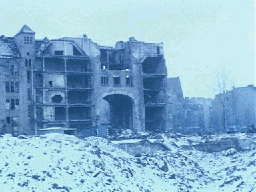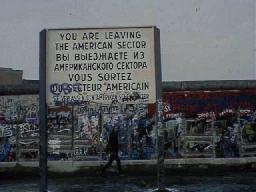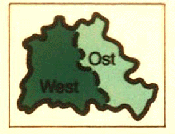 What the Allied bombers missed was finished off by Russian artillery and tanks. Almost half of its four million inhabitants were gone. But the city did not go under. Immediately after the War, the women (who else was there?) were set to work, trimming old mortar from the bricks with hammers, die Trümmerfrauen, the rubble-women. Other debris was piled up into several mountains, covered and planted with trees. Now, Berlin did two important things: it survived and rebuilt. What the Allied bombers missed was finished off by Russian artillery and tanks. Almost half of its four million inhabitants were gone. But the city did not go under. Immediately after the War, the women (who else was there?) were set to work, trimming old mortar from the bricks with hammers, die Trümmerfrauen, the rubble-women. Other debris was piled up into several mountains, covered and planted with trees. Now, Berlin did two important things: it survived and rebuilt.
Trümmerfrauen
Photo right courtesy of the © Deutsches Historisches Museum
 Politically, the Greater Berlin Area of 340 square miles was divided into four sectors, one for each of the Allies. The eastern part went to the Russians.The other Allied Powers, France, Britain and the U.S. divided the Western portion of the city among themselves. This arrangement reflected the Allied solution for the whole of Germany. Berlin was an island with special status governed by four nations in the sea of the Soviet Zone of Occupation. Previous underlying tensions between the Soviets and the Western Allies re-emerged and the world was launched on a new, long, dreary and debilitating period that was to hold us in deadly thrall to the present day. We called it, the Cold War. Politically, the Greater Berlin Area of 340 square miles was divided into four sectors, one for each of the Allies. The eastern part went to the Russians.The other Allied Powers, France, Britain and the U.S. divided the Western portion of the city among themselves. This arrangement reflected the Allied solution for the whole of Germany. Berlin was an island with special status governed by four nations in the sea of the Soviet Zone of Occupation. Previous underlying tensions between the Soviets and the Western Allies re-emerged and the world was launched on a new, long, dreary and debilitating period that was to hold us in deadly thrall to the present day. We called it, the Cold War. |
In 1947, the Western portion of Germany instituted a government under the watchful eyes of the Western Allies. The Soviet sector followed suit in 1949. During this period, the elaborate governance structure of greater Berlin broke under the strain of Cold War tensions.
 What emerged was West Berlin, which took up ties with West Germany, known as the Federal Republic of Germany. East Berlin, which comprised the ruins of the old and historic center of Berlin and outlying districts to the East, became the capital of the German Democratic Republic. After World War II, the Americans pumped capital into West Germany through the Marshall Plan, which resulted in one of the world's strongest economies, enormous prosperity and a stable democracy. Germany has been divided ever since and though at every opportunity, lip service was paid by all western nations to its eventual reunification, no one took the matter seriously - until now. What emerged was West Berlin, which took up ties with West Germany, known as the Federal Republic of Germany. East Berlin, which comprised the ruins of the old and historic center of Berlin and outlying districts to the East, became the capital of the German Democratic Republic. After World War II, the Americans pumped capital into West Germany through the Marshall Plan, which resulted in one of the world's strongest economies, enormous prosperity and a stable democracy. Germany has been divided ever since and though at every opportunity, lip service was paid by all western nations to its eventual reunification, no one took the matter seriously - until now.
Options: For Student Exercises in English and German to Part 1 click here!Proceed to Part 2: The First Postwar Decade or, switch to another Part:
1. Berlin at the End of WWII--Top of document
3. The Raising of the Wall
4. West Berlin thrives
5. East Berlin, a tourist attraction
6. East Germany during the Wall
7. Bringing down the Wall from within
8. East meets West
9. East German Problems
10. The Road to Unification
11. Return to Index
| |



 What the Allied bombers missed was finished off by Russian artillery and tanks. Almost half of its four million inhabitants were gone. But the city did not go under. Immediately after the War, the women (who else was there?) were set to work, trimming old mortar from the bricks with hammers, die Trümmerfrauen, the rubble-women. Other debris was piled up into several mountains, covered and planted with trees. Now, Berlin did two important things: it survived and rebuilt.
What the Allied bombers missed was finished off by Russian artillery and tanks. Almost half of its four million inhabitants were gone. But the city did not go under. Immediately after the War, the women (who else was there?) were set to work, trimming old mortar from the bricks with hammers, die Trümmerfrauen, the rubble-women. Other debris was piled up into several mountains, covered and planted with trees. Now, Berlin did two important things: it survived and rebuilt.